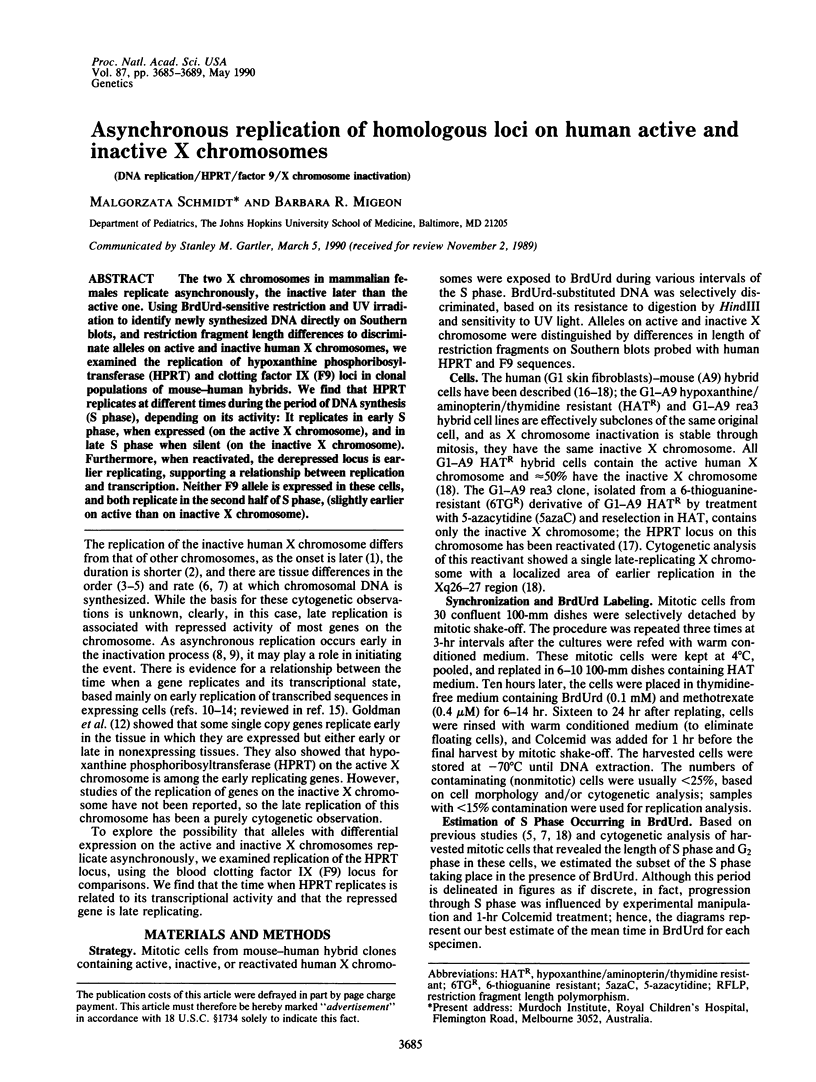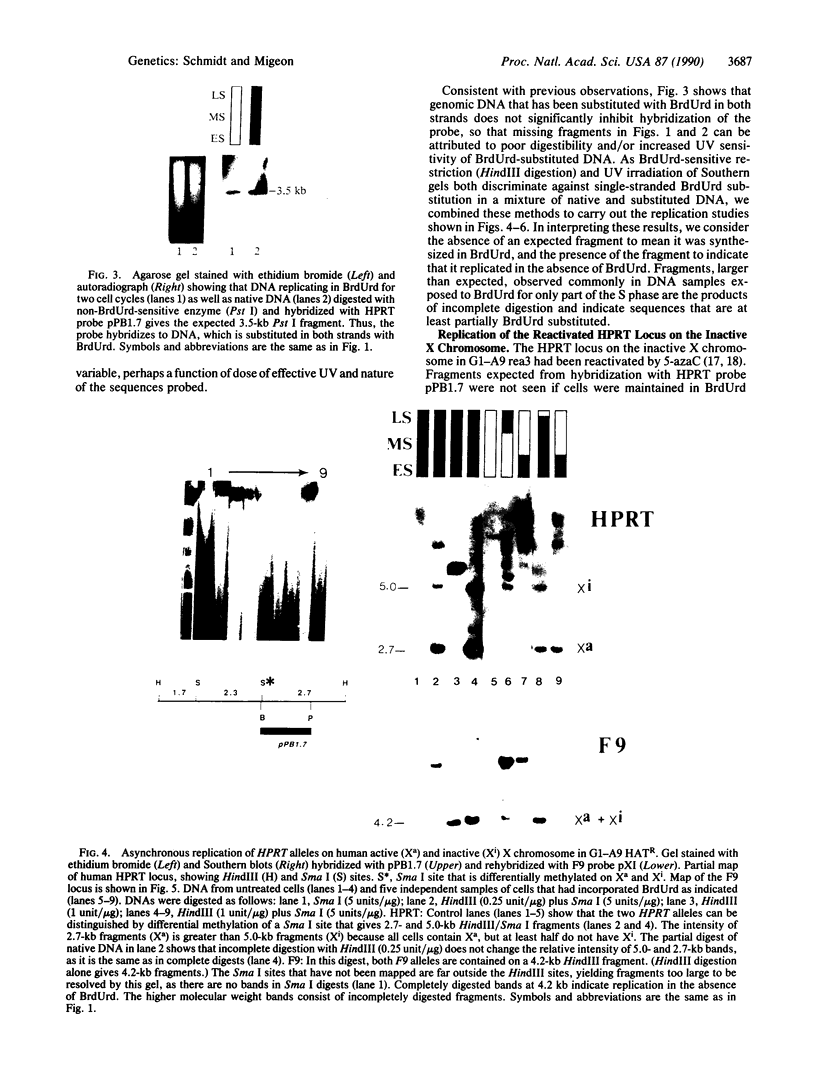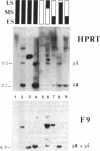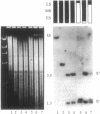Abstract
The two X chromosomes in mammalian females replicate asynchronously, the inactive later than the active one. Using BrdUrd-sensitive restriction and UV irradiation to identify newly synthesized DNA directly on Southern blots, and restriction fragment length differences to discriminate alleles on active and inactive human X chromosomes, we examined the replication of hypoxanthine phosphoribosyltransferase (HPRT) and clotting factor IX (F9) loci in clonal populations of mouse-human hybrids. We find that HPRT replicates at different times during the period of DNA synthesis (S phase), depending on its activity: It replicates in early S phase, when expressed (on the active X chromosome), and in late S phase when silent (on the inactive X chromosome). Furthermore, when reactivated, the derepressed locus is earlier replicating, supporting a relationship between replication and transcription. Neither F9 allele is expressed in these cells, and both replicate in the second half of S phase, (slightly earlier on active than on inactive X chromosome).
Full text
PDF




Images in this article
Selected References
These references are in PubMed. This may not be the complete list of references from this article.
- Anson D. S., Choo K. H., Rees D. J., Giannelli F., Gould K., Huddleston J. A., Brownlee G. G. The gene structure of human anti-haemophilic factor IX. EMBO J. 1984 May;3(5):1053–1060. doi: 10.1002/j.1460-2075.1984.tb01926.x. [DOI] [PMC free article] [PubMed] [Google Scholar]
- Calza R. E., Eckhardt L. A., DelGiudice T., Schildkraut C. L. Changes in gene position are accompanied by a change in time of replication. Cell. 1984 Mar;36(3):689–696. doi: 10.1016/0092-8674(84)90349-0. [DOI] [PubMed] [Google Scholar]
- Comings D. E. The duration of replication of the inactive X chromosome in humans based on the persistence of the heterochromatic sex chromatin body during DNA synthesis. Cytogenetics. 1967;6(1):20–37. doi: 10.1159/000129927. [DOI] [PubMed] [Google Scholar]
- Cullen C. R., Hubberman P., Kaslow D. C., Migeon B. R. Comparison of factor IX methylation on human active and inactive X chromosomes: implications for X inactivation and transcription of tissue-specific genes. EMBO J. 1986 Sep;5(9):2223–2229. doi: 10.1002/j.1460-2075.1986.tb04488.x. [DOI] [PMC free article] [PubMed] [Google Scholar]
- D'Andrea A. D., Tantravahi U., Lalande M., Perle M. A., Latt S. A. High resolution analysis of the timing of replication of specific DNA sequences during S phase of mammalian cells. Nucleic Acids Res. 1983 Jul 25;11(14):4753–4774. doi: 10.1093/nar/11.14.4753. [DOI] [PMC free article] [PubMed] [Google Scholar]
- Furst A., Brown E. H., Braunstein J. D., Schildkraut C. L. alpha-Globulin sequences are located in a region of early-replicating DNA in murine erythroleukemia cells. Proc Natl Acad Sci U S A. 1981 Feb;78(2):1023–1027. doi: 10.1073/pnas.78.2.1023. [DOI] [PMC free article] [PubMed] [Google Scholar]
- Gilbert D. M. Temporal order of replication of Xenopus laevis 5S ribosomal RNA genes in somatic cells. Proc Natl Acad Sci U S A. 1986 May;83(9):2924–2928. doi: 10.1073/pnas.83.9.2924. [DOI] [PMC free article] [PubMed] [Google Scholar]
- Goldman M. A., Holmquist G. P., Gray M. C., Caston L. A., Nag A. Replication timing of genes and middle repetitive sequences. Science. 1984 May 18;224(4650):686–692. doi: 10.1126/science.6719109. [DOI] [PubMed] [Google Scholar]
- Goldman M. A. The chromatin domain as a unit of gene regulation. Bioessays. 1988 Aug-Sep;9(2-3):50–55. doi: 10.1002/bies.950090204. [DOI] [PubMed] [Google Scholar]
- Holmquist G. P. Role of replication time in the control of tissue-specific gene expression. Am J Hum Genet. 1987 Feb;40(2):151–173. [PMC free article] [PubMed] [Google Scholar]
- Jolly D. J., Esty A. C., Bernard H. U., Friedmann T. Isolation of a genomic clone partially encoding human hypoxanthine phosphoribosyltransferase. Proc Natl Acad Sci U S A. 1982 Aug;79(16):5038–5041. doi: 10.1073/pnas.79.16.5038. [DOI] [PMC free article] [PubMed] [Google Scholar]
- Latt S. A., Barell E. F., Dougherty C. P., Lazarus H. Patterns of late replication in X chromosomes of human lymphoid cells. Cancer Genet Cytogenet. 1981 Mar;3(2):171–181. doi: 10.1016/0165-4608(81)90073-x. [DOI] [PubMed] [Google Scholar]
- Marchionni M. A., Roufa R. J. Digestion of 5-bromodeoxyuridine-substituted lambda-DNA by restriction endonucleases. J Biol Chem. 1978 Dec 25;253(24):9075–9081. [PubMed] [Google Scholar]
- Migeon B. R., Johnson G. G., Wolf S. F., Axelman J., Schmidt M. Hyperexpression of HPRT induced by 5-azacytidine in mouse-human hybrid reactivants. Am J Hum Genet. 1985 May;37(3):608–611. [PMC free article] [PubMed] [Google Scholar]
- Murray V., Martin R. F. The degree of ultraviolet light damage to DNA containing iododeoxyuridine or bromodeoxyuridine is dependent on the DNA sequence. Nucleic Acids Res. 1989 Apr 11;17(7):2675–2691. doi: 10.1093/nar/17.7.2675. [DOI] [PMC free article] [PubMed] [Google Scholar]
- Pai G. S., Sprenkle J. A., Do T. T., Mareni C. E., Migeon B. R. Localization of loci for hypoxanthine phosphoribosyltransferase and glucose-6-phosphate dehydrogenase and biochemical evidence of nonrandom X chromosome expression from studies of a human X-autosome translocation. Proc Natl Acad Sci U S A. 1980 May;77(5):2810–2813. doi: 10.1073/pnas.77.5.2810. [DOI] [PMC free article] [PubMed] [Google Scholar]
- Priest J. H., Heady J. E., Priest R. E. Delayed onset of replication of human X chromosomes. J Cell Biol. 1967 Nov;35(2):483–487. doi: 10.1083/jcb.35.2.483. [DOI] [PMC free article] [PubMed] [Google Scholar]
- Reed K. C., Mann D. A. Rapid transfer of DNA from agarose gels to nylon membranes. Nucleic Acids Res. 1985 Oct 25;13(20):7207–7221. doi: 10.1093/nar/13.20.7207. [DOI] [PMC free article] [PubMed] [Google Scholar]
- Schmidt M., Stolzmann W. M., Baranovskaya L. I. Replication variants of the human inactive X chromosome. I. Variability within lymphocytes of single individuals. Chromosoma. 1982;85(3):405–412. doi: 10.1007/BF00330363. [DOI] [PubMed] [Google Scholar]
- Schmidt M., Stolzmann W. M. Replication variants of the human inactive X chromosome. II. Frequency and replication rate relative to the other chromosomes of the complement. Chromosoma. 1984;89(1):68–75. doi: 10.1007/BF00302353. [DOI] [PubMed] [Google Scholar]
- Schmidt M., Wolf S. F., Migeon B. R. Evidence for a relationship between DNA methylation and DNA replication from studies of the 5-azacytidine-reactivated allocyclic X chromosome. Exp Cell Res. 1985 Jun;158(2):301–310. doi: 10.1016/0014-4827(85)90455-0. [DOI] [PubMed] [Google Scholar]
- Sugawara O., Takagi N., Sasaki M. Allocyclic early replicating X chromosome in mice: genetic inactivity and shift into a late replicator in early embrogenesis. Chromosoma. 1983;88(2):133–138. doi: 10.1007/BF00327333. [DOI] [PubMed] [Google Scholar]
- Takagi N., Endo S., Sugawara O. X chromosome inactivation in bone marrow cells of adult mice carrying Searle's X-autosome translocation: occurrence of the early-replicating inactive X chromosome. Cytogenet Cell Genet. 1984;38(1):62–69. doi: 10.1159/000132031. [DOI] [PubMed] [Google Scholar]
- Takagi N., Sugawara O., Sasaki M. Regional and temporal changes in the pattern of X-chromosome replication during the early post-implantation development of the female mouse. Chromosoma. 1982;85(2):275–286. doi: 10.1007/BF00294971. [DOI] [PubMed] [Google Scholar]
- Watanabe N., Akasaka K., Shiroya T., Obinata M., Shimada H. Replication timing: histone genes replicate during early S phase in cleavage-stage embryos of sea urchin. Nucleic Acids Res. 1986 Dec 9;14(23):9509–9519. doi: 10.1093/nar/14.23.9509. [DOI] [PMC free article] [PubMed] [Google Scholar]
- Willard H. F. Tissue-specific heterogeneity in DNA replication patterns of human X chromosomes. Chromosoma. 1977 Apr 27;61(1):61–73. doi: 10.1007/BF00292681. [DOI] [PubMed] [Google Scholar]
- Wolf S. F., Jolly D. J., Lunnen K. D., Friedmann T., Migeon B. R. Methylation of the hypoxanthine phosphoribosyltransferase locus on the human X chromosome: implications for X-chromosome inactivation. Proc Natl Acad Sci U S A. 1984 May;81(9):2806–2810. doi: 10.1073/pnas.81.9.2806. [DOI] [PMC free article] [PubMed] [Google Scholar]
- Yen P. H., Patel P., Chinault A. C., Mohandas T., Shapiro L. J. Differential methylation of hypoxanthine phosphoribosyltransferase genes on active and inactive human X chromosomes. Proc Natl Acad Sci U S A. 1984 Mar;81(6):1759–1763. doi: 10.1073/pnas.81.6.1759. [DOI] [PMC free article] [PubMed] [Google Scholar]









